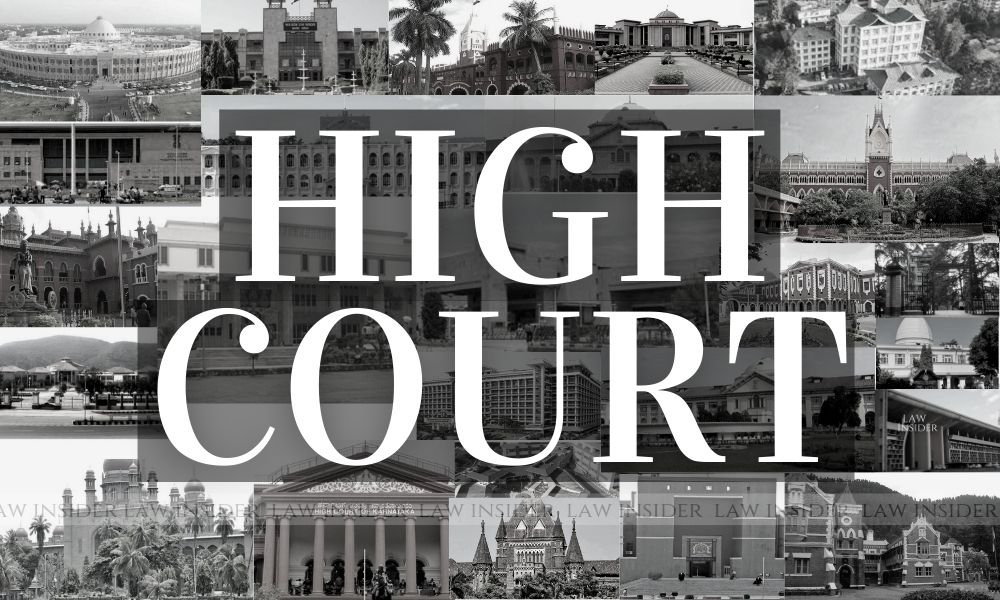By Pooja Bhakar
Introduction
“The primary duty of the Judiciary is to uphold the Constitution and the Laws without fear or favour, without being biased by political ideology or economic theory.”
Like the Supreme Court, the High Court has been vested with quite extensive and effective powers. It is highest Court of appeal in the state. It is the protector of the fundamental rights of the citizens.
The Constitution also confers some more additional powers on a High Court like-writ jurisdiction, power of superintendence, consultative power, etc. Moreover it empowers the Parliament and the state legislatures to change the jurisdiction and powers of a High Court.
Let’s know about all the details of the High Court in this article.
What are High Courts?
High Court generally refers to superior Court of a State. It is a primary judicial body at the State. Article 214-231 of The Indian constitution deals with provisions of High Courts in India.
Judges in High Court are appointed by the President of India in consultation with the Chief Justice of India and the Governor of the state. High Courts are headed by a Chief Justice.
The number of judges in a Court is decided by dividing the average institution of the main cases during the last five years by the national average, or the average rate of disposal of main cases per judge per year, in that High Court, whichever is higher.
High Courts that handle numerous cases of a particular region have permanent benches established there. Benches are also present in the states which come under the jurisdiction of the Court outside its territorial limits.
Circuit benches are the temporary Courts which hold proceedings for a few selected months in a year. Thus cases built up during this interim period are judged when the circuit Court is in session.
Powers of High Court
As a Court of record:
- High courts are also Courts of records.
- The records of the Judgments of the High Court can be used by subordinate courts for deciding cases.
- All High Courts have the power to punish all cases of contempt by any person or institution.
Administrative Powers:
- It superintends and controls all the subordinate Courts.
- It can ask for details of proceedings from subordinate Courts.
- It issues rules regarding the working of the subordinate Courts.
- It can transfer any case from one court to another and can also transfer the case to itself and decide the same.
- It can enquire into the records or the other connected documents of any subordinate courts.
- It can appoint its administration staff and determine their salaries and allowances, and conditions of service.
Power of Judicial review:
Under Article 13 of the Indian Constitution, the compulsion of judicial review was described in Fundamental rights in Part III.
A High Court alone can certify the cases fit for appeal before the Court.
- Judicial review is the power of a High Court to examine the constitutionality of legislative enactments and executive orders of both the central and state governments.
- On examination, if they are found to be voilative of the Constitution, they can be declared as illegal, unconstitutional and invalid by the High Court. Consequently, they cannot be enforced by the government.
- The constitutional validity of a legislative enactment or an executive order can be challenged in a High Court on the following three grounds:
- It infringes the fundamental rights.
- It is outside the competence of the authority which has framed it and;
- It is repugnant to the constitutional provisions.
Control over Subordinate Courts:
Article 235 of Constitution of India
In addition to its appellate jurisdiction and supervisory jurisdiction over the subordinate Courts as mentioned above, a High Court has an administrative control and powers over them. These include the following:
- It is consulted by the Governor in the matters of appointment, posting and promotion of district Judges and in the appointment of persons to the judicial service of the state.
- It deals with the matters of posting, promotion, grant of leave, transfers and discipline of the members of the judicial service of the state.
- It can withdraw a case pending in a subordinate Court if it involves substantial question of law that require the interpretation of the constitution.
- Its law is binding on all subordinate Courts functioning with its territorial jurisdiction in the same sense as the law declared by the Supreme Court is binding on all Courts in India.
Jurisdiction of High Court
Original Jurisdiction:
It means the power of a High Court to hear disputes in the first instance, not by way of appeal. It extends to the following:
- Matters of admirality, will, marriage, divorce, company laws and contempt of Court.
- Disputes relating to the selection of members of parliament and state legislatures.
- Regarding revenue matter or an act ordered or done in revenue collection.
- Enforcement of fundamental rights of citizens.
- Cases ordered to be transferred from a subordinate court involving the interpretation of the constitution to its own file.
Writ Jurisdiction:
A writ is a quick remedy against injustice, a device for the protection of the rights of the citizens against any encroachment by the governmental authority.
The Supreme Court has been empowered to issue writs in the nature of habeas corpus, mandamus, certiorari, prohibition and quowarrento for protecting the fundamental rights.(Article 32{2}). Similar power has been conferred on the High Courts via Article 226.
Article 226 of Constitution empowers a high court to issue writs including habeas corpus, mandamus, certiorari, prohibition and quowarrento for the enforcement of the fundamental rights of the citizens and for any other purpose.
The phrase “any other purpose” refers to the enforcement of an ordinary legal right.
A writ is a discretionary remedy and the High Court can refuse it on the Ground of acquiescence, delay, available alternate remedy and no benefit to the party. Under Article 226(3), High Court can grant interim relief by way of interlocutory orders.
Article 226(4), provides that the powers conferred on a High Court shall not be in derogation of the powers conferred on the Supreme Court by Article 32(2).
The writ jurisdiction of the High Court is not an exclusive but concurrent with the writ jurisdiction of the Supreme Court. It means, when the fundamental rights of a citizen are violated, the aggrieved party has the option of moving either the high Court or the Supreme Court directly.
The five well-known writs are:
Habeas Corpus:-
It literally means ‘to have a body of’. This writ is used to release a person who has been unlawfully detained or imprisoned. By virtue of this writ, the Court directs the person so detained to be brought before it to examine the legality of his detention. If the Court concludes that the detention was unlawful, then it directs the person to be released immediately.
While the Supreme Court can issue the writ of habeas corpus only against the state in cases of violation of fundamental rights, the High Court can issue it also against private individuals illegally or arbitrarily detaining any other person.
Related Case Law-
Sunil Batra v. Delhi Administration (1980 AIR 1579)
Mandamus:-
It is a command to act lawfully and to desist from perpetrating an unlawful act. It is issued by the Court to direct a public authority to perform the legal duties which it has not or refused to perform. It can be issued by the Court against a public official, public corporation, Inferior Court, tribunal or the Government. But it cannot be issued against a private individual or body, the President or the Governor of the state or against a working Chief Justice.
The High Court may issue this writ to direct an officer to exercise his constitutional and legal powers, to compel any person to discharge duties cast on him by the constitution or the statue, to compel a judicial authority to exercise its jurisdiction and to order the government not to enforce any unconstitutional law.
Related Case Law-
Praga Tools Corporation verses CVI Manual
Certiorari:-
It means to ‘certify’ or ‘to inform’. It is a curative writ. When the Court is of the opinion that a lower court or tribunal has passed an order which is beyond its powers or committed an error of law, then through the writ of certiorari, it may transfer the case to itself or quash the order passed by the lower court or tribunal.
Grounds for issuing the certiorari are-
- Lack of jurisdiction
- Excess of Jurisdiction
- Abuse of jurisdiction
- Violation of the principles of natural justice
- Error of law apparent on the face of the record
Related Case Law-
Syed Yakoob verses Radhakrishnan
Prohibition:-
This writ is issued by a Court to prohibit lower courts, tribunals and other quasi-judicial authorities from doing something beyond their authority. It is issued to direct inactivity and thus differs from mandamus which directs activity.
It is issued when the lower Court or tribunals acts without or in excess of jurisdiction or violation of rules of natural justice or in contravention of fundamental rights.
Prohibition is issued while judicial process is in motion to prevent it from proceeding further; Certiorari is issued to quash the proceedings and is therefore issued when the judicial process has ended in a decision. Thus, the object of writ of prohibition is in short ‘prevention’ rather than cure and certiorari is used as a ‘cure’.
Quowarrento:-
It is a question asking ‘by what warrant’. Through this writ, the Court calls upon a person holding a public office to show under what authority he holds that office. If it’s found that the person is not entitled to hold that office, he may be ousted from it. Its objective is to prevent a person from holding office he is not entitled to. It cannot be issued with respect to a private office.
Related Case Law-
Kumar Padma Padam Prasad v. Union of India
Appellate Jurisdiction:
A high Court is a primarily a Court of appeal. It hears appeals against the judgments of subordinate Courts functioning in its territorial jurisdiction. It has appellate jurisdiction in both civil and criminal matters.
Civil matters the civil appellate jurisdiction of a High Court as follows:-
- First appeals from the orders and judgements of the district Court, additional district Court and other subordinate Courts lie directly to the High Court.
- Second appeals from the orders and judgements of the district Court or other subordinate Courts lie to the High Court in the cases involving questions of law only.
- Appeals from the decisions of the administrative and other tribunals lie to the division bench of the state High Court.
Criminal matters The criminal appellate jurisdiction of a High Court is as follows:-
- Appeals from the judgements of sessions Court and additional sessions Court lie to the High Court if the sentence is one of the imprisonments for more than seven years. It should be noted here that death sentence awarded by a session Court or additional session Court should be confirmed by the High Court before it can be executed, whether there is an appeal by the convicted person or not.
- In some cases specified in various provisions in Criminal Procedure Code(1973), the appeals from the judgements of the assistant sessions Judge, metropolotian magistrate or other magistrates to the High Court.
Supervisory Jurisdiction:
A High Court has the power of superintendence over all Courts and Tribunals functioning in its territorial jurisdiction. Thus it may :-
- Call for returns from them;
- Make and issue, general rules and prescribe forms for regulating the practice and proceedings of them;
- Prescribe forms in which books, entries and accounts are to be kept by them; and
- Settle the fees payable to the sheriff, clerks, officers and legal practitioners of them.
Related Case Law:
Madras High Court
Sr.V.J Dhanapal vs Union Bank Of India
Inherent Powers of the High Court:
The object of the criminal law is to punish those who commit offence against society. Our country’s law of crimes is mainly maintained in code of Criminal Procedure, 1973. The code covers all provisions relating to crime and its punishment. However, if the Court finds that there is no specific provision dealing with a particular issue it has inherent power to pass orders which serve justice.
The Supreme Court has declared that no other Courts other than the High Courts have the inherent powers. These powers are mentioned in Section 482 of Chapter XXXVII of the code of criminal Procedure.
The principle underlying the inherent jurisdiction is “quando lex aliquid alicui concedit, concedere videtur ed it sine quo res ipsae esse non protest”. This means when law gives anything to anyone, it gives also all those things without which the thing itself would be unavailable.
The sole purpose of the inherent powers is to do the right and to undo a wrong.
Section 482 of the code reads as:
Nothing in this code shall be deemed to limit or affect the inherent powers of the High Court to make such orders as may be necessary:
- To give effect to any order this Code,or
- To prevent abuse of the process of any Court or,
- Otherwise to secure the ends of Justice.
Inherent powers of section 482 includes power to quash FIR, investigation or any criminal proceedings pending before the High Court or any Courts subordinate to it and are of wide magnitude and ramification. These powers are neither limited nor curtailed by any other provisions of the code. However, such inherent powers are to be exercised sparingly and with caution.
It is well settled that the inherent powers under sec482 can be exercised only when no other remedy is available to the litigant and NOT where a specific remedy is provided by the statute.
If an effective alternative remedy is available, the High Court will not exercise its power under this section, especially when the applicant may not have availed of that remedy.
Related Case Law-
State of Haryana v. Bhajan Lal (1992) Supp (1) SCC 335
How many High Courts are there in India?
At present there are 25 High Courts in different state and union territories. We have 29 states and 7 union territories so ideally there should be total of 36 High Courts but we are having a total of 25. This means some High Courts are having additional charges. These are:
- Bombay High Court- Maharashtra, Dadar and Nagar Haveli, Daman,Diu and Goa.
- Kolkata High Court -West Bengal and Andaman & Nicobar Islands.
- Madras High Court- Tamil Nadu and Pondicherry.
- Guwahati High Court- Assam, Nagaland, Mizoram and Arunachal Pradesh.
- Kerala High Court- Kerala and Lakshadweep islands.
- Punjab & Haryana High Court-Punjab, Haryana and Chandigarh.
Delhi is the only union territory which has a separate High Court.
Calcutta High Court is the oldest High Court established in 1862 and Telengana Court and Andhra Pradesh High Court are the newest High Court both established in 2019.Allahabad High Court is the biggest High Court.
List of all the High Courts in India-
Allahabad High Court
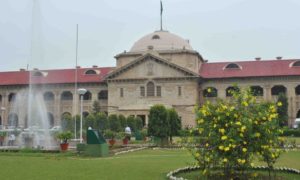
The Allahabad High Court is situated at Prayagraj that has jurisdiction over the Indian state Uttar Pradesh.
History–
It was established on 17 March 1866, making it one of the oldest High Court of India.
Allahabad become the seat of the government of North-Western Provinces and a High Court was established in 1834 but was shifted to Agra within a year. In 1869 it shifted back to Allahabad.
Allahabad High Court was built by Khan Saheb Nizamuddin of Loha Mundi, Agra, India.
About High Court–
- The seat of the Court is at Allahabad.
- Allahabad High Court maintains a permanent circuit bench at Lucknow, the administrative capital of the state.
- The maximum number of serving judges is 160, the highest in India.
- Justice Sanjay Yadav is the current acting Chief Justice of the High Court.
Official website of Allahabad High Court
Andhra Pradesh High Court
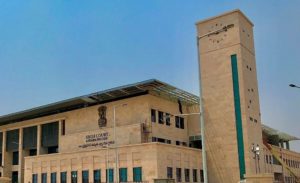
Also known as Andhra High Court.
History–
The High Court was established in the year 1954 when the state was formed from the earlier Madras Residency. After the merger of the Hyderabad state with the Andhra state to form the state of Andhra Pradesh, the Court initially continued at Guntur till 1956.
- The seat of the Court is at Kurnool.
- The High Court is currently located at Amaravati. The government of Andhra Pradesh has however decided and passed a bill in the state legislature to shift the Principle seat of High Court at Kurnool.
- The Court has a sanctioned strength of 37 judges.
Official website of Andhra Pradesh High Court
Bombay High Court
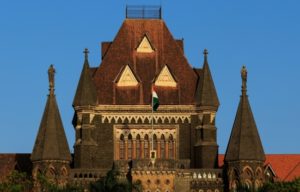
Also known as Mumbai High Court. It is one of the oldest High Court in India, located at Mumbai, Maharashtra.
History–
- The first Chief Justice, the Attorney General and Solicitor General of Independent India were from this Court.
- It was designed by British engineer Col. James A Fuller.
- The first sitting in this building was on 10 January 1879.
- Justice M.C.Chagla was the first Indian permanent Chief Justice of Bombay High Court after Independence.
Benches–
Nagpur Bench
- A full-fleged High Court was established at Nagpur on 9 January 1936. Later it was included as a separate bench in the Bombay High Court jurisdiction after the formation of the state of Maharashtra in 1960.
- Sir Gilbert Stone, a judge of Madras High Court was appointed as the first Chief Justice.
- During the year 1960, the strength of this bench consisted of four Honourable Judges.
- Presently, the strength of this Bench consists of 10 Honourable Judges and total employees are 412.
Aurngabad Bench
- It was established in 1982.
- Initially only few districts of Maharashtra were under the Aurangabad bench, subsequently in 1988, Ahemadnagar and other districts were attached to this bench.
- The jurisdiction of the Aurangabad Bench is over Aurangabad, Ahmednagar, Dhule, Nandurbar, Jalna, Jalgaon, Beed, Parbhani, Latur & Osmanabad.
- This bench also has a bar council Maharashtra and Goa office.
Panaji Bench
About High Court–
- The High Court has regional branches at Nagpur and Aurangabad in Maharashtra and Panaji, the capital of Goa.
- The Court has original jurisdiction in addition to its appellate.
- The decisions of this court can be appealed only to the Supreme Court of India
- The High Court has a sanctioned strength of 94 judges.
- The present Chief Justice of the Court is Justice Dipankar Datta.
Official website of Bombay High Court
Calcutta High Court
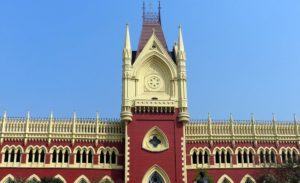
It is the oldest High Court in India. It is located in BBD, Bagh, Kolkata, West Bengal.
History–
- The Calcutta High Court is one of the three High Courts established at the Presidency Towns by Letters Patent granted by Queen Victoria, bearing date 26 June 1862, and the oldest High Court in India.
- The Bill to rename it as Kolkata High Court was approved by the Union Cabinet on 5 July 2016.
- The Bill called High Courts(Alternation of names) bill was introduced in Lok Sabha on 19 July 2016 and is yet to be passed by both Houses of Parliament. Hence, the High Court still retains the old name.
- Sir Barnes Peacock was the first Chief Justice of the High Court.
- Justice Romesh Chandra was first Indian officiating Chief Justice and Justice Phani Bhushan Chakravartti was the first Indian permanent Chief Justice of the Court.
About High Court–
- The seat of the Calcutta High Court is at Kolkata, capital of West Bengal.
- The Calcutta High Court extended its circuit bench in Port Blair, the capital of Andaman and Nicobar Islands and in Jalpaiguri, West Bengal with the jurisdiction are within 5 districts.
- The current acting Chief Justice of the Court is Justice Rajesh Bindal.
- The Court has sanctioned judge strength of 72 judges.
Official website of Calcutta High Court
Chhattisgarh High Court
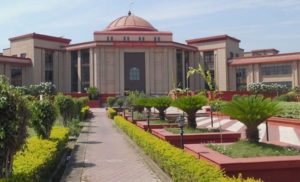
The High Court is located at village Bodri, Bilaspur. It is the 19th High Court of India.
History–
It was established on 1 November 2000 with the creation of new State of Chhattisgarh upon the reorganization of the state of Madhya Pradesh.
About High Court–
- Justice R.S.Garg was the first acting chief justice of the Court.
- The Court has the sanctioned judge strength of 18 and the maximum strength of the High Court is 22 in which 17 seats for permanent judges and 5 seats for additional judges.
Official website of Chhattisgarh High Court
Delhi High Court
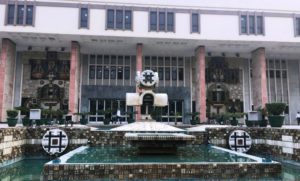
The High Court of Delhi was established on 31st October 1966. The High Court was established with four judges including Chief Justice KS Hedge, Justice ID Dua, Justice HR Khanna and Justice SK Karpur.
History–
- Initially, the High Court of Judicature at Lahore, which was established by Letters Patent dated 21st March 1919, exercised jurisdiction over the then provinces of the Punjab and Delhi. This position continued till the Indian Independence Act, 1947 when the dominions of India and Pakistan were created.
- The High Court’s (Punjab) orders, 1947 established a new High Court territory of what was then called the East Punjab with effect from 15th August 1947. The Indian order provided that any reference in an existing Indian law to the High Court of Judicature at Lahore is replaced by a reference to the High Court of East Punjab.
- The High Court of East Punjab started functioning from Shimla in a building called “Peterhoff”. This building burnt down in January, 1981.
- When the Secretariat of the Punjab Government shifted to Chandigarh in 1954-55, the High Court also shifted to Chandigarh. The High Court of Punjab, as it is later came to be called, exercised jurisdiction over Delhi through a Circuit Bench which dealt with the cases pertaining to the Union Territory of Delhi and the Delhi Administration.
- In the view of importance of Delhi, its population and other considerations, Parliament thought it necessary to establish a new High Court of Delhi. This was achieved by enacting the Delhi High Court Act, 1966 on 5th September, 1966.
- The High Court of Delhi initially exercised jurisdiction not only over the Union Territory of Delhi, but also Himachal Pradesh. The High Court of Delhi had a Himachal Pradesh Bench at Shimla in a building called Ravenswood.
- The High Court of Delhi continued to exercise jurisdiction over Himachal Pradesh until the State of Himachal Pradesh Act, 1970 was enforced on 25th January, 1971.
About High Court–
- The High Court of Delhi is territory. This means that civil cases can be filed directly in the High Court, whereas the High Court generally only has appellate civil jurisdiction otherwise. The other High Courts which have original side jurisdiction are Bombay, Calcutta, Madras, and Himachal Pradesh.
- The Court has sanctioned strength of 45 permanent judges and 15 additional judges.
Official website of Delhi High Court
Guwahti High Court
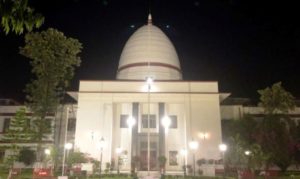
It was originally known as the High Court of Assam and Nagaland , but renamed as Gauhati High Court in 1971 by the North-Eastern Areas Act ,1971. It has the largest jurisdiction in terms of state.
History–
- The Guwahati High Court was promulgated by governor general of India on 1 March 1948 after the Government of India Act 1935 was passed. Establishing the High Court of Assam with effect from 5 April 1948, for the then Province of Assam.
- It was inaugurated on 5 April 1948 by H. J. Kania, the Chief Justice of India. Sir R.F. Lodge was sworn in as the first Chief Justice of the Assam High Court on the same day.
- Assam High Court initially had its sittings at Shillong but shifted to Guwati on 14 August 1948.
- Later, when Nagaland state was created on 1 December 1963, the Assam High Court was renamed as the High Court of Assam and Nagaland.
- After Meghalaya, Manipur and Tripura got its High Court, the Gauhati High Court ceased its jurisdiction in these three states.
- It has largest jurisdiction in terms of states, with covering the areas of Assam, Arunachal Pradesh, Nagaland and Mizoram.
About High Court–
- The Court has 3 outlying benches:
- Tthe Principle seat of the Gauhati High Court is Guwahti, Assam.
- The Kohima bench for Nagaland state (established on 1 December 1972)
- The Aizawl bench for Mizoram state (established on 5 July 1990)
- The Itanagar bench for Arunachal Pradesh state (established on 12 August 2000)
- Permanent Judge for the Nagaland state was Justice Lanusungkum Jamir, Elevated as Additional Judge on 22 May 2013.
- Permanent Judge for Arunachal Pradesh state was Justice Pranoy Kumar Musahary (01/07/2008 – Till Date) retired now
- Permanent Judge for Mizoram State was Justice MR Pathak, Elevated as Additional Judge of the Gauhati High Court on 22 May 2013 and Justice Michael Zothankhuma , Elevated as Additional Judge, Gauhati High Court on 7 January 2015.
- Justice A.S.Bopanna is currently serving justice in the Court.
Official website of Guwahti High Court
Gujarat High Court
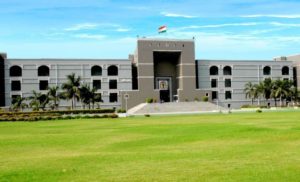
It was established in 1960.
History–
- The High Court was established on 1 May 1960 as a result of bifurcation of the former State of Bombay into two States of Maharashtra and Gujarat.
- The High Court has later shifted to the new building at Sarkhej – Gandhinagar Highway, Sola, Ahmedabad, Gujarat on January 1999.
About High Court–
- The seat of the Court is Ahemdabad.
- It has jurisdiction on all district, administrative and other courts in Gujarat.
- The High Court is a Court of record and empowered to punish anyone for contempt of court.
- It also has power to issue various writs to Courts and authority under its jurisdiction. Intra-Court appeals, when permissible under Clause – 15 of Letters Patent, also lie within the same court from decision of a Single Judge to a Division Bench which comprises two Judges.
- It has power of superintendence on all courts under it under Article 227 of the Constitution of India.
- The High Courts are also empowered to hear Public Interest Litigations.
- The present strength of the Gujarat High Court is 30 against sanctioned strength of 52, which includes 39 permanent posts and 13 additional posts.
- The present chief justice of the Court is Justice Vikram Nath.
Official website of Gujarat High Court
Himachal Pradesh High Court
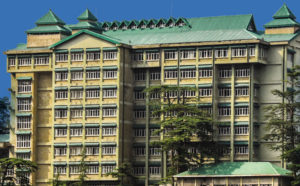
History–
- The Central Government promulgated the Himachal Pradesh (Courts) Order, 1948 on 15 August 1948. As per Paragraph 3 of this Order, the Court of Judicial Commissioner was established for Himachal Pradesh and the Court was housed at “Harvingtan” (Kelston area, Bharari, Shimla).
- It was vested with the powers of a High Court under the Judicial Commissioner’s Court Act, 1950. The Court of Judicial commissioner started functioning on 15 August 1948.
- The Punjab High Court rules and orders with suitable amendments were made applicable.
- The State of Himachal Pradesh Act was passed by Parliament and the new state came into being on 25 January 1971 and established its own High Court with headquarters at “Revenswood” Shimla, having one Hon’ble Chief Justice and two Hon’ble Judges.
About High Court–
- The seat of the Court is Shimla, the administrative capital of the state.
- The Court has sanctioned judge strength of 13 including the Chief Justice.
- Justice Lingappa Narayana Swamy is the present chief justice of the Court.
Official website of Himachal Pradesh High Court
Jammu & Kashmir High Court
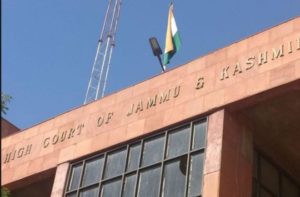
The High Court is the Common High Court for union territory of Jammu and Kashmir and Ladakh.
History–
- It was established in 1928, by letters patent issued by the Maharaja of Jammu and Kashmir, it was established on the basis of the Order No. 1 issued by the Maharaja on 26 March 1928.
- The Maharaja appointed Lala Kanwar Sain as the first Chief Justice and Lala Bodh Raj Sawhney and Khan Sahib Aga Syed Hussain as puisne judges.
- The seats of the High Court were at Jammu and Srinagar. On 10 September 1943, letters patent were conferred on the High Court by the Maharaja. Khan Sahib Aga Syed Hussain was the first Muslim Judge of the High Court, He retired as Home and Judicial Minister of Jammu & Kashmir during the Maharaja Rule.
- In August 2018, the Jammu and Kashmir High Court got its first and second woman judges. Sindhu Sharma who was appointed as a Judge and Justice Gita Mittal who was appointed as the Chief Justice of the J&K High Court.
- In August 2019, a Reorganisation Bill was passed by both houses of the Indian Parliament. The provisions contained in the bill reorganised the state of Jammu and Kashmir into two union territories; Jammu and Kashmir (union territory) and Ladakh with effect from 31 October 2019.
About High Court–
- The Court has sanctioned judge strength of 17 in which 13 are permanent judges and 4 are additional judges.
- The current chief justice of the Court is Justice Pankaj Mithal, appointed on 3 January 2021.
Official website of Jammu & Kashmir High Court
Jharkhand High Court
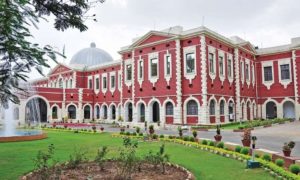
It is one of the newest High Courts in India, established in 2000.
History–
- A circuit bench of the Patna High Court was established at Ranchi on 6 March 1972 under clause 36 of the letters patent of the Patna High Court.
- The Circuit bench became the Permanent Bench of the Patna High Court, by the High Court at Patna (Establishment of Permanent Bench at Ranchi) Act 1976 (Act 57 of 1976) on 8 April 1976. This Permanent Bench finally became the Jharkhand High Court on reorganisation of Bihar state on 15 November 2000.
About High Court–
- The seat of the Court is at Ranchi, the administrative capital of the state.
- The court has sanctioned judge strength of 25.
- Justice Dr.Ravi Ranjan is the present chief justice of the Court since 17 November 2019.
Official website of Jharkhand High Court
Karnataka High Court
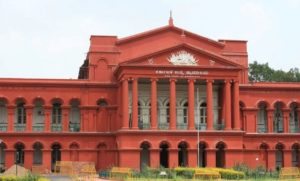
About High Court–
- The Court’s principal bench is located in Banglore, the administrative capital of the state, with additional benches in Hubli-Dharwad and Gulbarga.
- It was previously called the High Court of Mysore.
- In Bangalore, the High Court functions out of a red-painted brick building known as the Attara Kacheri, located opposite the Vidhana Soudha, the seat of the legislature of Karnataka.
- The Court has sanctioned judge strength of 62.
- Justice Abhay Shreeniwas Oka is the current chief justice of the Court, since 10 May 2019.
Additional Benches–
- The Karnataka High Court is currently functional in Bangalore, Dharwad and Gulbarga. There was a long-standing demand for an additional bench as the location of Bangalore in south-east corner of the state caused hardship for people visiting the High Court from the distant northern regions of the state.
- This issue led to agitation, including boycott of court proceedings by lawyers in the northern region.
- The demand was finally met in the year 2006 when it was decided that circuit benches of the High Court would be set up in Dharwad and Gulbarga.
- The new branches were inaugurated on 4 and 5 July 2008, respectively. There was later demand to make both Dharwad and Gulbarga benches permanent.
- Consequently, Dharwad circuit bench became a permanent bench from 25 August 2013 and Gulbarga circuit bench became a permanent bench from 31 August 2013.
Official website of Karnataka High Court
Kerala High Court

It is located at Kochi. The High Court has the superintendence and visitorial jurisdiction over all courts and tribunals of inferior jurisdiction covered under its territorial jurisdiction.
History–
- The present State of Kerala is result of integrating the erstwhile princely kingdoms of Travancore and Cochin with Malabar district and Kasaragod.
- The present judicial system in Kerala has its roots dating back to the days of the monarchs of the Kingdoms of Travancore and Cochin.
- In 1811, following the 1808 insurrection against British Cochin and Quilon, Colonel H. M. Munro succeeded Colonel Macaulay as the Resident in Travancore with supervision over the Kingdom of Cochin.
- Following an investigation into the rampant lawlessness and the abuse of the system, Colonel Munro surveyed the region with his assistant Captain Blacker and established reforms including courts, pensions, construction of roads, bridges and schools. He functioned as the Diwan until February 1818 when he handed over the reins to Nanjappayya of Coimbatore.
- Thus it was Colonel Munro laid the foundations for a systematic legal system, resulting in the present day scenario. Until his time, there were no independent tribunals for the administration of justice.
- On 1 November 1956, the States Reorganisation Act, 1956 was passed thereby integrating the State of Travancore-Cochin with Malabar district and Kasaragod to form the present State of Kerala.
- The Kerala High Court Act, 1958 defined the jurisdiction and various functions, and powers of the High Court of Kerala.
- Initially, many cases from both the Travancore-Cochin High Court and the High Court of Madras were transferred to the High Court of Kerala for adjudication.
- Justice K. T. Koshi was appointed as the first Chief Justice of High Court of Kerala.
About High Court–
- The court has a sanctioned judge strength of 27 permanent judges including the Chief Justice and 20 additional Judges.
- Justice S.Manikumar is the current chief justice of the Court.
Official website of Kerala High Court
Madhya Pradesh High Court
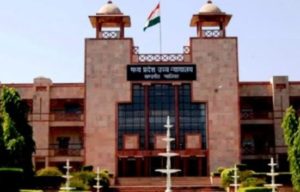
It is located at Jabalpur. It was established as the Nagpur High Court on 2 January 1936 by Letters Patent dated 2 January 1936, issued under Section 108 the Government of India Act, 1935. This Letters Patent continued in force even after the adoption of the constitution of India on 26 January 1950 by virtue of Articles 225 & 372 thereof.
History-
- The Judicial Commissioner’s court at Nagpur was, at that time, the highest Court of the territory. It was converted into a Governor’s province in 1921, when it became entitled to a full-fledged High Court for administration of Justice.
- Later, Berar, a part of Nizam’s state of Hyderabad, was transferred in 1933 to the Central Province, for administration. This gave the state its new name Central Provinces and Berar.
- Thereafter, by virtue of Letters Patent dated 2 January 1936, issued under Section 108 of the Government of India Act, 1915, by King Emperor, George the Fifth, the Nagpur High Court was established for Central Pronvices and Berar.
- This Letters Patent, under which the Nagpur High Court was constituted and invested with jurisdiction, continued to remain in force even after the adoption of the constitution of India on 26 January 1950, by virtue of Articles 225 & 372 thereof.
- On 1 November 1956, the new state of Madhya Pradesh was constituted under States Reorganisation Act. Subsection (1) of Section 49 of the States Re-organisation Act ordained that from the appointed day, the High Court exercising jurisdiction, in relation to the existing state of Madhya Pradesh, shall be deemed to be the High Court for the present state of Madhya Pradesh.
- Thus Nagpur High Court was not abolished but by a legal fiction it became High Court for the new state of Madhya Pradesh with its seat at Jabalpur.
- Hon’ble the Chief Justice, vide order dated 1 November 1956 constituted temporary benches of the High Court of Madhya Pradesh at Indore and Gwalior.
- Later, by a Presidential Notification Dt. 28 November 1968, issued in the exercise of the powers conferred by the Subsection (2) of section 51 of the States Reorganization Act, 1956, permanent benches of the High Court of Madhya Pradesh at Indore and Gwalior were established.
- This state of affairs continued till 1 November 2000, when the state of Chhattisgarh was carved of the existing state of Madhya Pradesh by virtue of the provisions of the Madhya Pradesh Reorganization Act, 2000 and the High Court of Chhattisgarh was established for that state with its seat at Bilaspur.
- The High Court of Madhya Pradesh at Jabalpur then became High Court for the successor state of Madhya Pradesh.
About High Court-
- The principal seat of the court is in Jabalpur.
- The Court has sanctioned judge strength of 53.
Official website of Madhya Pradesh High Court
Madras High Court
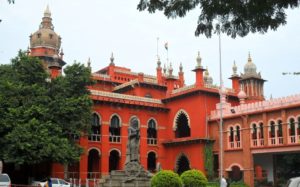
It is the second oldest High Court of India. It is located in Chennai, Tamil Nadu.
The court is one of the three High Courts in India established in the three Presidency Towns of Madras, Bombay and Calcutta by letters patent granted by Queen Victoria, bearing date 26 June 1862.
History–
- From 1817 to 1862, the Supreme Court of Madras was situated in a building opposite the Chennai Beach railway station. From 1862 to 1892, the High Court was also housed in that building.
- The present buildings were officially inaugurated on 12 July 1892, when the then Madras Governor, Beilby, Baron Wenlock, handed over the key to the then Chief Justice Sir Arthur Collins.
- The Madras High Court was formed by merging the Supreme Court of Judicature at Madras, and the Sadr Diwani Adalat.
- The first Indian to sit as a judge of the High Court was Justice T. Muthuswamy Iyer. Other early Indian judges included Justices V. Krishnaswamy Iyer and P. R. Sundaram Iyer.
- Although the name of the city was changed from Madras to Chennai in 1996, the Court as an institution did not follow suit and retained the name as the Madras High Court.
- However, a Bill to rename the Madras High Court as the Chennai High Court was approved by the cabinet on 5 July 2016, along with the change of name of the Calcutta High Court and Bombay High Court as Kolkata High Court and Mumbai High Court, respectively.
- The Bill is yet to be passed by both Houses of Parliament. However, the Tamil Nadu Legislative Assembly has passed a unanimous resolution appealing to the Central Government to rename the court as High Court of Tamil Nadu since the Court serves the whole state.
About High Court–
- It consists of 74 judges and a chief justice who are in charge of the general policy adopted in the administration of justice.
- The court currently has 57 judges, including the Chief Justice.
- Justice Sanjib Banerjee is the current chief justice of the Court.
Official website of Madras High Court
Manipur High Court
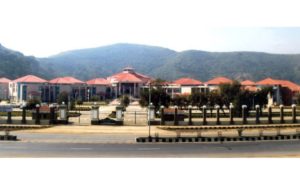
- It was established in 25 March 2013, after making suitable amendments in the Constitution of India and North-Eastern Areas (Re-organisation) Act, 1971.
- The seat of the high court is at Imphal, the administrative capital of the state.
- Earlier, a bench of the Gauhati High Court used to have jurisdiction over the state of Manipur.
- The first chief justice is Justice Abhay Manohar Sapre.
Official website of Manipur High Court
Mehghalya High Court
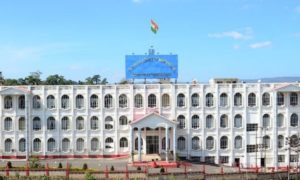
- It was established in March 2013, after making suitable amendments in the Constitution of India and North-Eastern Areas (Re-organisation) Act of 1971.
- The seat of the High Court is at Shillong, the administrative capital of the state.
- The Court has sanctioned judge strength of 4 permanent judges including the chief justice.
- Justice Biswanath Somadder is the current Chief Justice of the Court, who took oath on 27 April 2020.
Official website of Mehghalya High Court
Orrisa High Court
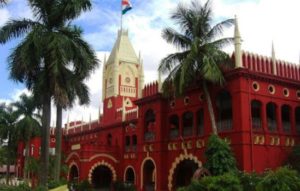
The seat of the High Court is at Cuttack.
History–
- New province of Bihar and Orissa was formed on 22 March 1912. However, the said new province of Bihar and Odisha was under the jurisdiction of Calcutta High Court.
- On 9 February 1916, in exercise of the powers under Section 113 of the Government of India Act, 1915, the King of England issued letters of patent constituting High Court of Patna. Odisha was placed under the jurisdiction of Patna High Court.
- Although, on 18 May 1916, Circuit Court of Patna High Court for Odisha held its first sitting at Cuttack.
- On 1 April 1936, Odisha was made a separate province but no separate High Court was provided for it. The Government of India agreed to create a new High Court, and for that purpose the Government of India issued the Odisha High Court Order, 1948, under the Section 229(1) of the Government of India Act, 1935, on 30 April 1948.
- Finally, on 26 July 1948, Odisha High Court was formally inaugurated.
About High Court–
- The Court has a sanctioned judge strength of 27.
- Justice S.Muralidhar is the current Chief Justice of the Court, since 4 January 2021.
Official website of Orrisa High Court
Patna High Court
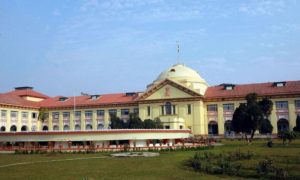
The seat of the High Court is at Patna, the administrative capital of the state.
Justice Sanjay Karol is the current Chief Justice of the Court.
History-
- The Patna High Court building on its completion was formally opened by the same Viceroy on 3 February 1916.
- Hon. Sir Justice Edward Maynard Des Champs Chamier was the first Chief Justice of this High Court. Starting 18 April 2015, the Patna High Court has planned year long centenary celebrations of 100 years of establishment and the occasion was inaugurated by the President of India Shri Parnab Mukherjee chaired by the Governor of Bihar Shri Keshari Nath Tripathi and Chief Justice of India, Justice Mr.H. L. Dattu and the Chief Justice of Patna High Court Justice Mr.L. Narasimha Reddy.
- Patna High Court opened a Circuit Bench at Ranchi in 1972.
- Circuit Bench of Patna High Court at Ranchi became Permanent Bench in 1976.
- Hon. Ms. Justice Rekha Doshit was the Chief Justice of Patna High Court; and the first woman to hold this coveted office.
Official website of Patna High Court
Punjab & Haryana High Court
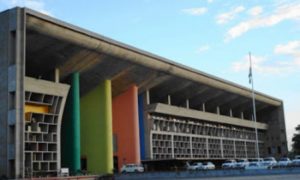
The seat of the High Court is at Chandigarh.
History–
- Punjab and Haryana High Court was formerly known as Lahore High Court, which was established on 21 March 1919. The jurisdiction of that court covered undivided Punjab and Delhi.
- From 1920 to 1943, the Court was conferred with extraterritorial jurisdiction over that part of China that formed part of the British consular district of Kashgar, which had previously been under the jurisdiction of the British Supreme Court for China. This ceased upon the ratification of the British-Chinese Treaty for the Relinquishment of Extra-Territorial Rights in China.
About High Court-
- The Court has sanctioned judge strength of 56 judges (39 permanent and 17 additional judges).
- The Court building is known as Palace Of Justice.
- Justive Ravi Shankar Jha is the current Chief Justice of the Court.
Official website of Punjab & Haryana High Court
Rajasthan High Court
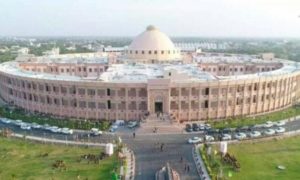
The seat of the High Court is at Jodhpur.
History-
- It was established on 29 August 1949 under the Rajasthan High Court Ordinance, 1949.
- The Rajasthan High Court Ordinance, 1949 abolished these different jurisdictions and provided for a single High Court for the entire State. The High Court of Rajasthan was founded in 1949 at Jaipur, and was inaugurated by the Rajpramukh, Maharaja Sawai Man Singh on 29 August 1949, later on after complete integration of Rajasthan in 1956 it was moved at Jodhpur with recommendation of satyanarayan rao committee.
- The first Chief Justice was Kamala Kant Verma. A bench was formed at Jaipur on 31 January 1977 under sub-section (2) of Section 51 of the States Reorganisation Act, 1956 which was dissolved in 1958.
About High Court-
- The Court has sanctioned judge strength of 50 and actual strength is 34.
- Justice Indrajit Mahanty is the current Chief Justice of the Court.
Official website of Rajasthan High Court
Sikkim High Court
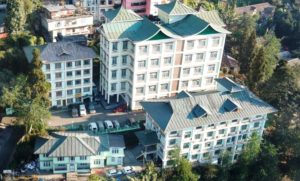
The seat of the High Court is at Gangtok, the administrative capital of the state.
History-
- The history of the Court can be traced back to 1955, when the High Court of Judicature (Jurisdiction and Powers) Proclamation, 1955 was issued to establish a High Court in Sikkim.
- Upon merger, Sikkim became the 22nd State of India. Under Clause (i) of Article 371F, the High Court functioning immediately prior to the date of merger became the High Court for the State of Sikkim under the Constitution like any other High Court in the country.
- It was established in 1975.
About High Court-
- The Court has sanctioned judge strength of 3 judges. It is the smallest High Court of India.
- Justice J.K.Maheshwari is the current Chief Justice of the Court from 6 January 2021.
Official website of Sikkim High Court
Telengana High Court
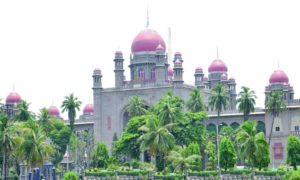
The seat of the High Court is at Hyderabad. Initially, it was set up as High Court of Hyderabad for the then Princely State of Hyderabad Deccan and later renamed High Court of Andhra Pradesh, as it was set up on 5 November 1956 under the States Reorganisation Act, 1956.
History-
- The President of India, on 26 December 2018, issued orders bifurcating The High Court of Judicature at Hyderabad for the State of Telangana and the State of Andhra Pradesh into High Court of Andhra Pradesh with the principal seat at Amaravati and High Court for the State of Telangana with the principal seat at Hyderabad.
- On 1 January 2019, Telangana High Court was bifurcated into Andhra Pradesh High Court and Telangana High Court after the formation of the state of Telangana.
About High Court-
- The Court has sanctioned judge strength of 24 judges.
- Justice Hima Kholi is the current Chief Justice of the Court.
Official website of Telengana High Court
Tripura High Court
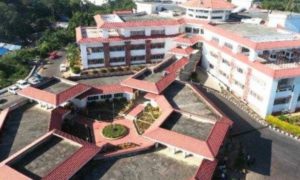
The seat of the High Court is at Agartala, the administrative capital of the state.
History-
- It was established on 23 March 2013, after making suitable amendments in the Constitution of India and North-Eastern Areas (Re-organisation) Act, 1971.
- The first Chief Justice was Justice Deepak Gupta.
- Earlier, the state of Tripura along with the other six states of the North – East of India was under the Gauhati High Court , a permanent bench of the Gauhati High Court was established in Agartala in the year 1992 having territorial jurisdiction of the state of Tripura.
About High Court-
- Justice Akil Abdulhamid Kureshi is the current Chief Justice of the Court, since 16 November 2019.
Official website of Tripura High Court
Uttarakhand High Court
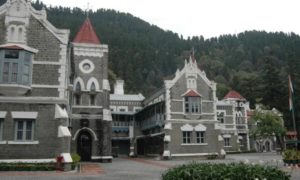
The seat of the High Court is at Nainital.
History-
- The building of Uttarakhand High Court was constructed by Santoni MacDonald in 1900.
- The Uttarakhand State was carved out from the State of Uttar Pradesh on 9 November 2000 under the Uttar Pradesh Reorganisation Act, 2000.
- Former Chief Justices of Uttarakhand Sarosh Homi Kapadia and Jagdish Singh Khehar later went on to become Chief Justice of India.
About High Court-
- The Court has sanctioned judge strength of 9 judges.
- Justice Raghvendra Singh Chauhan is the current Chief Justice of the Court from 7 January 2021.
Official website of Uttarakhand High Court
| Territorial Jurisdiction, Seat and Bench of High Courts in India | |||
| Year of Establishment | Name | Territorial Jurisdiction | Seat & Bench |
| 1862 | Bombay | Maharashtra
Dadra & Nagar Haveli and Daman Diu Goa |
Seat: Mumbai
Bench: Panaji, Aurangabad, and Nagpur |
| 1862 | Kolkata | West Bengal
Andaman & Nicobar islands |
Seat: Kolkata
Bench: Port Blair |
| 1862 | Madras | Tamil Nadu
Pondicherry |
Seat: Chennai
Bench: Madurai |
| 1866 | Allahabad | Uttar Pradesh | Seat: Allahabad
Bench: Lucknow |
| 1884 | Karnataka | Karnataka | Seat: Bengaluru
Bench: Dharwad and Gulbarga |
| 1916 | Patna | Bihar | Patna |
| 1948 | Guwahati | Assam
Nagaland Mizoram Arunachal Pradesh |
Seat: Guwahati
Bench: Kohima, Aizawl, and Itanagar |
| 1949 | Odisha | Odisha | Cuttack |
| 1949 | Rajasthan | Rajasthan | Seat: Jodhpur
Bench: Jaipur |
| 1956 | Madhya Pradesh | Madhya Pradesh | Seat: Jabalpur
Bench: Gwalior and Indore |
| 1958 | Kerala | Kerala & Lakshadweep | Ernakulam |
| 1960 | Gujarat | Gujarat | Ahmedabad |
| 1966 | Delhi | Delhi | Delhi |
| 1971 | Himachal Pradesh | Himachal Pradesh | Shimla |
| 1975 | Punjab & Haryana | Punjab, Haryana & Chandigarh | Chandigarh |
| 1975 | Sikkim | Sikkim | Gangtok |
| 2000 | Chattisgarh | Chattisgarh | Bilaspur |
| 2000 | Uttarakhand | Uttarakhand | Nainital |
| 2000 | Jharkhand | Jharkhand | Ranchi |
| 2013 | Tripura | Tripura | Agartala |
| 2013 | Manipur | Manipur | Imphal |
| 2013 | Meghalaya | Meghalaya | Shillong |
| 2019 | Telangana | Telangana | Hyderabad |
| 2019 | Andhra Pradesh | Andhra Pradesh | Amravati |
| 2019 | Jammu & Kashmir | Jammu and Kashmir
Ladakh |
Shrinagar |

